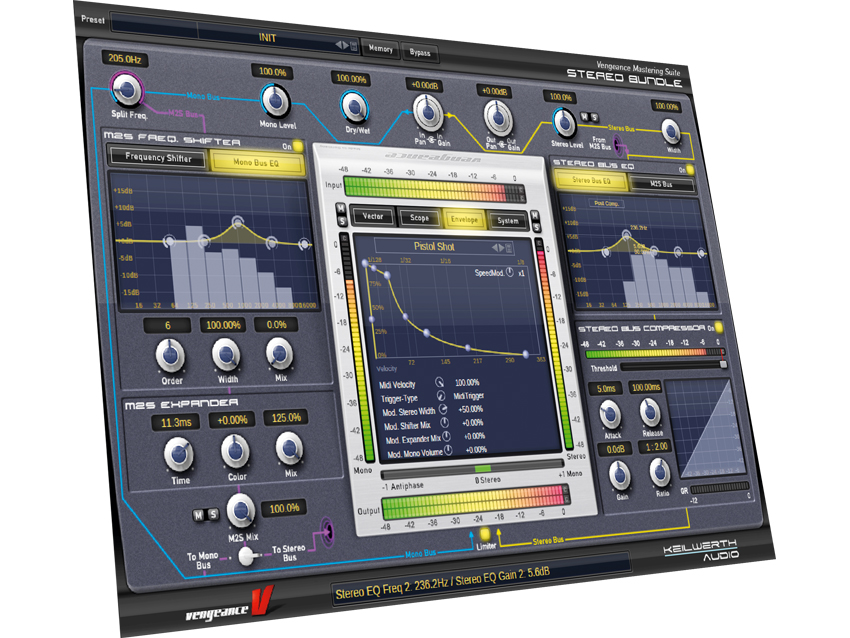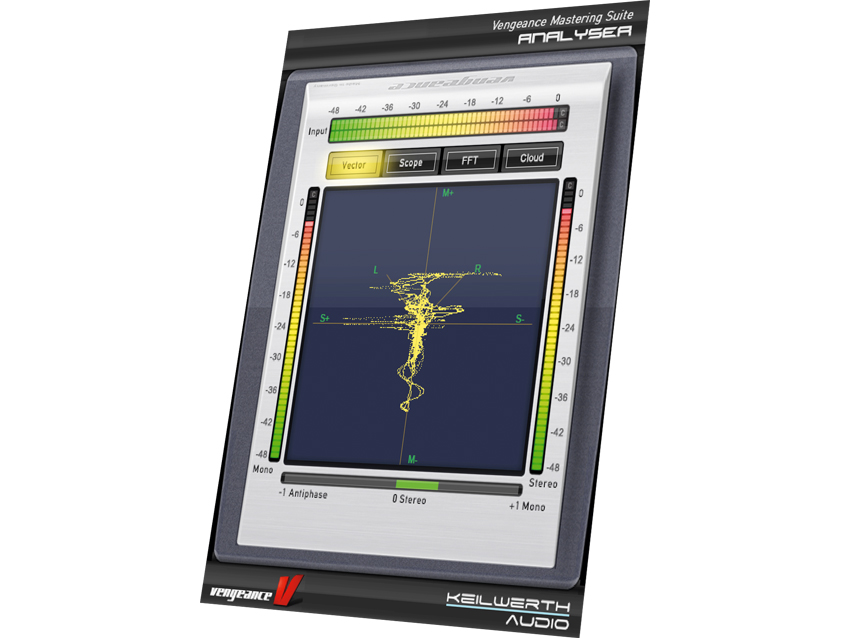MusicRadar Verdict
From subtle enhancement to ultra-wide weirdness, this plug-in caters for all stereo situations.
Pros
- +
Plenty of metering options. Five plugins at a reasonable price. Wide range of effects.
Cons
- -
Interface takes some getting used to.
MusicRadar's got your back

Vengeance Mastering Suite: Stereo Bundle

Vengeance Mastering Suite: Stereo Bundle

Vengeance Mastering Suite: Stereo Bundle
Stereo placement is a crucial part of the mixing process. With the right tools and a bit of know-how you can carve out a special place for every element in the sound stage.
Enter the Stereo Bundle, a new suite of toys. Inside the toolbox you'll find five separate plug-ins. The first four are one-job processors, known as the M2S Shifter, M2S Expander, Stereo Splitter and VMS analyser.
"There's a lot of scope for totally changing the tone of the signal along with the stereo placement."
The fifth one - aka the Stereo Bundle, combines all the previous plugs together and adds several extra features including EQs, an envelope trigger and a couple dynamics processors.
The installation requires a Synchrosoft dongle, so budget for that if you don't already own one.
Route down
When you open the Stereo Bundle the first thing you'll notice is that there's a lot of information to take in from the GUI.
Aside from all the controls there's also the signal path, which isn't immediately obvious. This definitely needs to be fully understood to get a good idea of what's happening to your audio when it passes through.
Initially the signal gets divided into its mono and stereo components. The blue line signifi es the mono buss and heads left, while the yellow arrows take the stereo buss over to the right. This split allows you to make a stereo signal sound wider by lowering the volume of the mono portion of the signal while keeping the stereo information intact or vice versa for reducing the stereo image.
Want all the hottest music and gear news, reviews, deals, features and more, direct to your inbox? Sign up here.
Split point
The first processor on the mono chain is the M2S (mono to stereo) splitter. This allows you to split the signal at any point in the frequency spectrum. You can then leave the lower part unprocessed in hard mono, and route the upper part to the M2S Frequency shifter.
The shifter can make a mono signal into a stereo one by employing a series of comb filters. You can specify between two and ten points (or filters) that are graphically represented on the display. These are panned in opposing directions to create the illusion of width.
The three simple controls are easy to use and can dial in results ranging from subtle width to some seriously over-the-top spread.
At this point you can also take advantage of a five-band EQ to tweak these newly spread frequencies, and then it's off to the M2S Expander. This can also make mono signals stereo and uses copies with slightly different delay times (up to 10ms long) to create the illusion.
The manual assuredly claims this process is 100% phase-free and mono compatible, and in our tests it held up and collapsed nice and tight.
So far, the mono signal has been split and made stereo, the next option is to route it all to the output, or to mix it with the stereo buss over on the right. The mono signal joins up with the yellow stereo buss on the right, where it has its own five-band EQ.
Remember that if the signal is already in stereo, then the stereo portion can be levelled and processed separately using its own five-band EQ as well, before both signals are routed into the stereo buss compressor.
The analyser section sits in the middle of the GUI. You can switch between the Vector-style stereo analyser, and the scope, which displays the waveform and frequency action.
The square formation also features four level meters, which cover the input, output, mono and stereo busses.
Wide boys
There is a little bit of a learning curve, but once you acquaint yourself with the signal path, it becomes a lot easier to keep track of what your doing with your audio.
For instant gratification, hit the preset list. They show off the depth of what it can offer and it comes loaded with banks for mastering, instruments, envelope triggers and special FX. These are geared towards dance music production, and tend to be quite dramatic when applied, you should immediately hear the difference in the sound stage.
In terms of sound quality, as more of the M2S processing is added, there is tendency for things to get brighter. The shifter tends to make things sound a little more resonant around the frequencies it's boosting, while the colour parameter on the expander also increases the brightness.
In fact, there's a lot of scope for totally changing the tone of the signal along with the stereo placement, so we found that we needed to stay objective with the mix and not go too heavy, otherwise we'd need to EQ.
At the most extreme settings, it can make real-world acoustic spaces sound unnatural, like they are hanging around in an intangible area and you cant quite put your finger on where they are located.
On the other hand, this ability to push it too far is great for in-your-face special effects and crazy sound design applications.
Future Music is the number one magazine for today's producers. Packed with technique and technology we'll help you make great new music. All-access artist interviews, in-depth gear reviews, essential production tutorials and much more. Every marvellous monthly edition features reliable reviews of the latest and greatest hardware and software technology and techniques, unparalleled advice, in-depth interviews, sensational free samples and so much more to improve the experience and outcome of your music-making.
